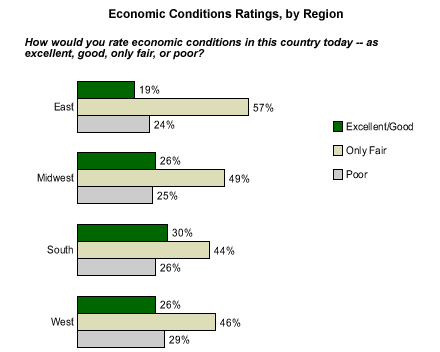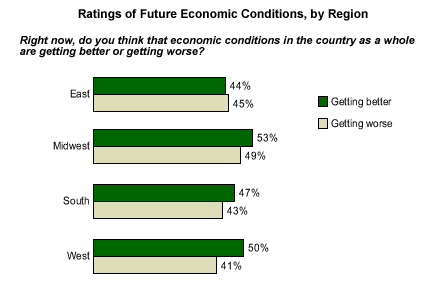Americans have no shortage of information about how the national economy is doing. Frequent media reports on stock market gains and losses, changes in the Gross Domestic Product, and unemployment trends can all influence Americans' perceptions of the economy and future economic conditions. However, survey results commonly indicate that Americans also consider much more personal criteria in their assessments of the economy, such as the size of the bills they pay each month.
Gallup researchers aggregated economic data from three recent polls in October and November*, and examined public opinion on the economy in the four main regions of the United States -- the East, South, Midwest, and West**. The Gallup numbers, when compared with regional data from the U.S. Bureau of Labor Statistics' Consumer Price Index, suggest that people living in areas of the country where prices are rising fastest are more negative about the U.S. economy than other Americans are.
The Gallup results show mixed reviews on the current state of the economy, and with the exception of those in the East, more people perceive the economy to be "getting better" than "getting worse." Easterners are currently the least likely to rate economic conditions in the United States as "excellent" or "good." Nineteen percent of Easterners described economic conditions this way, compared with 26% of Midwesterners, 30% of Southerners, and 26% of those living in the West.

When it comes to judging the direction of the economy, Easterners currently have a darker view than other Americans do of where things are headed, as a plurality of those in the East (45%) think economic conditions are getting worse. Easterners are less likely than Midwesterners and those in the West to say conditions are getting better. Southerners aren't quite as optimistic about the economy as those in the Midwest and West -- 47% said it is getting better and 43% worse.

The Consumer Price Index measures the changes in prices paid by urban consumers for a variety of goods and services. The September Consumer Price Index data (the most recent data available as of this writing) show the Northeast region has the greatest rate of acceleration, followed by the South, West, and finally the Midwest. This same ordering occurs in the regional data on the proportion who said in the October and November polls that economic conditions are getting worse.

Bottom Line
Americans' checkbooks and stock portfolios, in addition to the reports they hear about unemployment and economic growth, may influence their economic outlooks for the nation. While the tax cuts may have stimulated consumer spending, regional polling breakouts suggest that increasing optimism that preceded and followed the recent news about surging economic growth may be countered by increased inflation. It remains to be seen whether rising inflation and a mounting budget deficit will temper economic optimism brought about by economic growth, continued low interest rates, and possibly reduced unemployment.
*Results are based on a total of 3,030 telephone interviews with national adults, aged 18 and older, conducted in polls Oct. 6-8, 2003, Oct. 24-26, 2003, and Nov. 3-5, 2003. There were 600 interviews conducted in the East region, 704 conducted in the Midwest, 1,055 conducted in the South, and 671 conducted in the West. For results in the South, one can say with 95% confidence that the margin of sampling error is ±3 percentage points. For results in the East, Midwest, and West, one can say with 95% confidence that the margin of sampling error is ±4 percentage points.
The East Census region includes: Maine, New Hampshire, Vermont, Massachusetts, Connecticut, New York, New Jersey, and Pennsylvania.
The South Census region includes: Maryland, Delaware, West Virginia, District of Columbia, Virginia, North Carolina, South Carolina, Georgia, Florida, Kentucky, Tennessee, Alabama, Mississippi, Arkansas, Louisiana, Oklahoma, and Texas.
The Midwest Census region includes: Ohio, Michigan, Indiana, Illinois, Wisconsin, Minnesota, Iowa, Missouri, North Dakota, Nebraska, South Dakota, and Kansas.
The West Census region includes: Montana, Arizona, Colorado, Idaho, Wyoming, Utah, Nevada, New Mexico, California, Oregon, and Washington.

